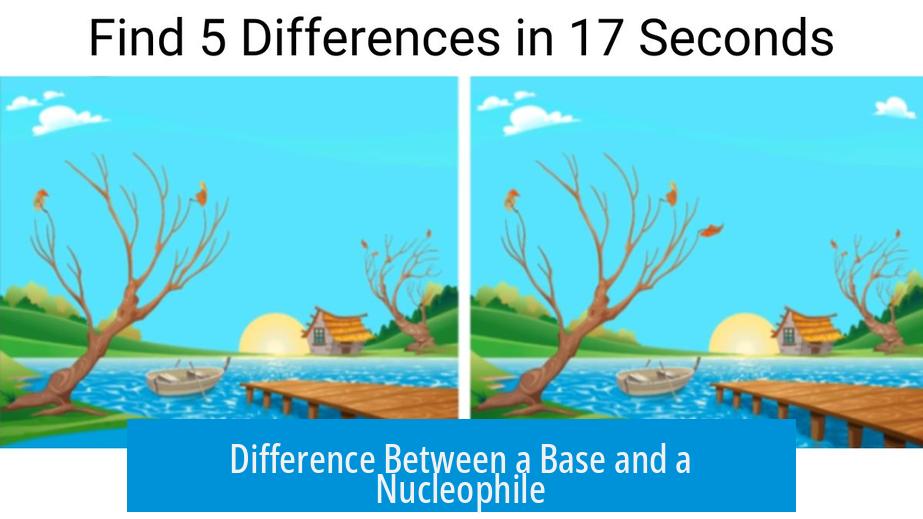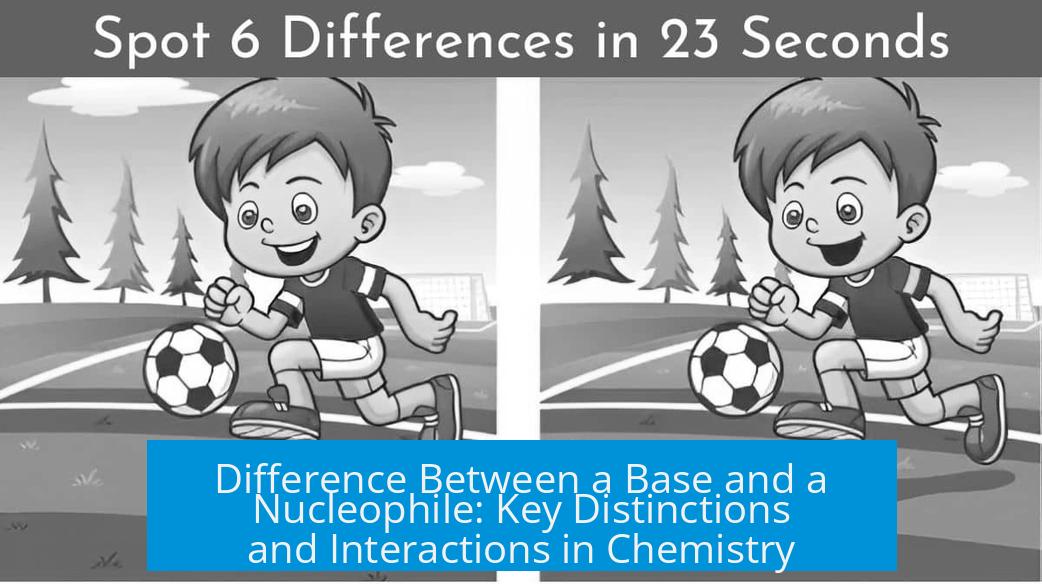Difference Between a Base and a Nucleophile

A base is primarily a proton acceptor, focusing on bonding with hydrogen ions (H+), while a nucleophile is an electron pair donor that forms bonds by attacking electrophiles such as carbon atoms.
Definitions and Core Roles
- Base: A base accepts protons (H+). It donates a pair of electrons to form a bond with hydrogen, neutralizing acids in the process. Bases preferentially abstract protons during chemical reactions.
- Nucleophile: A nucleophile donates an electron pair to an electrophile, commonly attacking electron-deficient atoms like carbons to form covalent bonds.
In brief, bases target protons, whereas nucleophiles target electron-deficient atoms.
Overlap and Distinctions
- All nucleophiles qualify as Lewis bases because they donate electron pairs.
- However, not all bases act as nucleophiles. Some bases are sterically hindered and cannot attack typical electrophiles.
- Examples of species acting both as bases and nucleophiles include hydroxide (OH−) and alkoxides (RO−).
- Non-nucleophilic bases like sodium tert-butoxide are bulky, meaning they abstract protons effectively but rarely attack carbon electrophiles.
Thermodynamic vs Kinetic Perspectives

| Concept | Description |
|---|---|
| Basicity | Thermodynamic measure of proton affinity; how strongly a species holds onto a proton. |
| Nucleophilicity | Kinetic concept reflecting how fast a nucleophile attacks an electrophile. |
Factors Influencing Nucleophilicity but not Basicity
- Sterics: Bulky groups hinder nucleophilic attack by blocking access to the electrophile.
- Size of proton: Because a proton is small, bases can abstract protons despite steric hindrance.
Additional Complexity: Hard and Soft Acids/Bases
The distinction becomes more nuanced when considering hard and soft acid/base theory, where soft nucleophiles prefer soft electrophiles and vice versa. This classification affects their reactivity profiles but goes beyond basic differences.
Key Takeaways

- Bases accept protons (H+); nucleophiles donate electron pairs to electrophiles.
- All nucleophiles are bases, but not all bases are nucleophiles due to steric and electronic factors.
- Basicity is thermodynamic; nucleophilicity is kinetic.
- Steric hindrance impacts nucleophilicity, not basicity.
- Some bases, called non-nucleophilic bases, do not attack electrophiles despite proton affinity.
The Difference Between a Base and a Nucleophile: Chemistry’s Subtle Tug of War
Simply put, a base is a molecule that steals protons (H+), whereas a nucleophile is a molecule that donates an electron pair to an electrophile. That’s the heart of the matter. But if you thought this was straightforward, buckle up — chemistry loves to add layers of complexity and nuance.
Let’s dive into this gripping tale of electrons, atoms, and the clash between “stealing protons” versus “attacking electrophiles.”
1. What Exactly Are Bases and Nucleophiles?
Imagine a base as a knight whose quest is to nab a proton (H+). It’s all about proton acceptance. This means that bases are electron-rich species with a heroic mission — grabbing onto hydrogen ions to neutralize acids.
Meanwhile, nucleophiles, also electron-rich, have a slightly different goal. They seek out positively charged or electron-deficient sites called electrophiles. Instead of just swooping in for the proton, nucleophiles offer up their lone pair of electrons to form a bond. Think of nucleophiles as social butterflies looking to share electrons and create new connections.
In essence, a base is a specialized nucleophile focused primarily on proton binding. All bases count as nucleophiles, but not all nucleophiles fit neatly into the base category.
2. The Overlap That Makes Chemistry Quirky

Now here’s where it gets interesting: all nucleophiles are bases by definition because they donate electrons, but the reverse isn’t true. Not every base enjoys the thrill of nucleophilic attack.
Some bases, called non-nucleophilic bases, are like the strong but shy types. Take sodium or potassium tert-butoxide or LDA (lithium diisopropylamide). These bases are bulky. Imagine trying to shake hands through a door while wearing boxing gloves — that’s their steric hindrance for you.
Because they’re so large, these bases can’t effectively approach electrophiles to donate electrons. Instead, they stick to their job of stealing protons without mingling much beyond that.
3. Thermodynamics Meets Kinetics: A Clash of Concepts
Here’s a tasty tidbit for those who linger in the chemistry cafes.
Basicity is thermodynamic. It’s a measure of how strongly a molecule wants to snatch up a proton when the dust settles—that is, the stability of the products in the long run.
Nucleophilicity, on the other hand, is kinetic. It relates to how fast a molecule will attack an electrophile. So you can be a good base (strong proton grabber) but a lousy nucleophile (slow or bulky in attacking electrophiles), or vice versa.
An example: hydroxide ion (OH-) is both a good base and a good nucleophile, while tert-butoxide is a good base but a poor nucleophile because of its bulkiness.
4. Why Size and Shape Matter: Steric Effects Explored
The size and shape of a molecule play a starring role in nucleophilicity — more than in basicity. Because hydrogen ions are teeny, bases don’t have to worry about steric crowding when grabbing protons. Their main task is simple: snatch protons wherever they can.
For nucleophiles, however, the race to bond with electrophiles is competitive and requires them to physically get close enough. Bulky nucleophiles face traffic jams around the electrophile. This reduces their nucleophilicity but doesn’t affect how good they are as bases.
5. The Hard and Soft World: When Simple Definitions Don’t Cut It
Oh, but chemistry wouldn’t be fun without adding a bit of drama! Enter the “hard” and “soft” acids and bases.
This concept classifies bases and nucleophiles by how polarizable or reactive they are—a factor influenced by the electronic environment. Hard bases (like OH-) react better with hard acids (protons, for example), while soft bases deal with soft acids (like some metal ions). This nuanced interaction can blur the lines between base and nucleophile even further.
Essentially, the hard-soft acid-base theory complicates the picture by adding preferences and reactivity tendencies on top of the basic roles.
Why Should You Care?
Whether you’re a student tackling organic chemistry or a professional chemist designing synthetic routes, understanding this difference is crucial. It will help you predict reaction outcomes, choose the right reagents, and even troubleshoot unexpected results.
For example, knowing that tert-butoxide won’t act as a nucleophile can prevent you from scratching your head when no substitution reaction occurs. Instead, it favors elimination because it’s a strong base but bulky enough to dodge nucleophilic attacks.
Quick Recap Table
| Characteristic | Base | Nucleophile |
|---|---|---|
| Primary action | Accepts protons (H+) | Donates electron pair to electrophiles |
| Role in reaction | Neutralizes acids | Forms new bonds with electrophiles |
| Thermodynamics vs Kinetics | Thermodynamic concept | Kinetic concept |
| Steric effects | Minor impact | Major impact |
| Overlap | All bases are nucleophiles? No | All nucleophiles are bases? Yes |
| Examples | Sodium tert-butoxide, LDA (bulky bases) | Hydroxide ion (OH-), cyanide ion (CN-) |
Final Thought: Chemistry’s Subtle Dance
So, the next time you encounter the terms base and nucleophile in your chemical adventures, remember their little dance. Bases are about proton grabbing, nucleophiles about electron sharing. The line blurs due to steric hindrance, reaction speeds, and the intriguing world of hard and soft acids/bases.
Want to predict a reaction better? Ask yourself:
- Is this species likely to grab a proton or attack an electrophile?
- How big or crowded is this molecule?
- Will thermodynamic stability or kinetic speed dominate?
Answer these, and you’re on your way to mastering the subtle but crucial difference between a base and a nucleophile.
What is the main difference between a base and a nucleophile?
A base mainly accepts protons (H+), while a nucleophile donates an electron pair to form bonds with electrophiles. Bases focus on proton acceptance, nucleophiles on electron donation.
Can a chemical species be both a base and a nucleophile?
Yes, some species like hydroxide (HO⁻) or alkoxide (RO⁻) act as both. They accept protons and also donate electron pairs to electrophiles.
Why are some bases called non-nucleophilic?
Non-nucleophilic bases, such as tert-butoxide or LDA, are bulky. Their size prevents them from approaching electrophiles to donate electrons, so they only abstract protons.
How do steric effects influence nucleophilicity but not basicity?
Nucleophilicity depends on how easily a molecule can approach and donate electrons, so bulky groups reduce it. Basicity involves proton acceptance, less affected by size since H+ is small.
What is the difference between basicity and nucleophilicity in terms of chemistry concepts?
Basicity is a thermodynamic property showing how well a species accepts protons. Nucleophilicity is a kinetic concept describing the rate at which a species donates electrons to electrophiles.





Leave a Comment